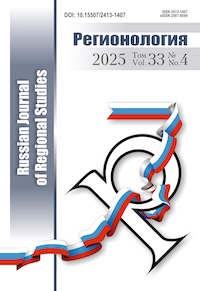M. I. Kоlykhalоv. Theoretical Aspects of the International Activity of Megacities in the Transnational Urban Network
UDК 332.1:004(470+571)
DOI: 10.15507/2413-1407.121.030.202204.961-979
Abstract
Introduction. The international activities of megacities in current circumstances are undergoing significant transformations, and new phenomena are emerging that require updating research approaches, clarifying and supplementing the terminology database. The purpose of the article is to explore various types of global cities, based on leading research concepts, to identify the presence of an interconnected system of the genesis of these categories, highlight key features and determine universal criteria for classifying megacities as one or another type of global city, clarify or define key concepts that characterize this object of study.
Materials and Methods. As research materials, current works of leading domestic and foreign researchers, as well as data from leading rating agencies and analytical centers in the field of urban studies and urban planning have been used. Methodological basis is made up of a system approach, structural-functional analysis, and an inductive method, which made it possible to reveal the structure of the transnational urban system, to explore the main factors, to determine the general trends and patterns of this object of study.
Results. The analysis of the main research concepts of global cities, including “the world city”, “the global city”, “the international city”, “the global information city”, has been carried out, the criteria and features for distinguishing these categories have been proposed, the genesis models and the principles for determining the actual composition of these categories of cities have been studied. The following terms have been clarified or defined. A conceptual framework for the genesis of global cities has been proposed.
Discussion and Conclusion. The study revealed that international power centers form a transnational urban network, the nodes of which are urban centers, while global economy, represented by advanced service and manufacturing companies, acts as links. The article is useful to researchers of scientific issues of international activities of subnational territorial units, and can also be used by the relevant central or regional authorities in developing directions or concepts for the development of urban centers as international centers of influence.
Keywords: megapolis, global city, world city, international city, political phenomenon
Conflict of interests. The author declares that there is not conflict of interest.
For citation: Kоlykhalоv M.I. Theoretical Aspects of the International Activity of Megacities in the Transnational Urban Network. Regionology. Russian Journal of Regional Studies. 2022;30(4):961–979. doi: https://doi.org/10.15507/2413-1407.121.030.202204.961-979
REFERENСES
1. Lebedeva M.M. System of Political Organization of The World: ‘Perfect Storm’. MGIMO Review of International Relations. 2016;(2):125–133. (In Russ., abstract in Eng.) doi: https://doi.org/10.24833/2071-8160-2016-2-47-134-144
2. Lebedeva M.M., Sergeev V.M. [Megapolis as an Actor of World Politics]. Kosmopolis. 2004;(4):193–200. Available at: https://elibrary.ru/item.asp?id=20897369 (accessed 28.07.2022). (In Russ., abstract in Eng.)
3. Sluka N.A. Evolution of the Conception “World Cities”. Regional’nye issledovaniya. 2005;(1):11–29. Available at: https://elibrary.ru/item.asp?id=28860945 (accessed 28.07.2022). (In Russ., abstract in Eng.)
4. Sluka N.A. “Geopolitical Challenge” to the Global Urban Research Boom. MGIMO Review of International Relations. 2020;13(3):283–294. (In Russ., abstract in Eng.) doi: https://doi.org/10.24833/2071-8160-2020-3-72-283-294
5. Dickson F. The Internationalization of Regions: Paradiplomacy or Multi-Level Governance? Geography Compass. 2014;8(10):689–700. doi: https://doi.org/10.1111/gec3.12152
6. Royles E. Sub-State Diplomacy: Understanding the International Opportunity Structures. Regional and Federal Studies. 2017;27(4):393–416. doi: https://doi.org/10.1080/13597566.2017.1324851
7. Taylor P.J., Walker D.R.F., Beaverstock J.V. Firms and Their Global Service Networks. In: Sassen S., editor. Global Networks, Linked Cities. London: Routledge; 2002. p. 93–116. doi: https://doi.org/10.4324/9781315538808
8. Sluka N.A., Karyakin V.V., Kolyasev E.F. Global Cities as the Hubs of New Transnational Actors. Outlines of Global Transformations: Politics, Economics, Law. 2020;13(1):203–226. (In Russ., abstract in Eng.) doi: https://doi.org/10.23932/2542-0240-2020-13-1-11
9. Bulycheva E.V. Diplomatic Activities by Technitai of Dionysus in Athens (II–I Centuries Bc). Metamorfozy istorii. 2018;(11):55–63. Available at: https://www.elibrary.ru/item.asp?id=32870336 (accessed 28.07.2022). (In Russ., abstract in Eng.)
10. Elizarov M.V. The Differences and Similarities between Sparta and Athens’s Political Systems. Doklady Bashkirskogo universiteta. 2017;2(1):187–192. Available at: http://dokbsu.ru/archive/2017/1/34 (accessed 28.07.2022). (In Russ., abstract in Eng.)
11. Kazakov D.V. [Proxenia as a Projection of Xenic Relations on Interpolis Communication]. Belgorod State University. Scientific Bulletin. Series: History. Political Science. 2011;(1):5–9. Available at: https://www.elibrary.ru/item.asp?id=17431921 (accessed 28.07.2022). (In Russ.)
12. Shmeleva L.M. Power and Diplomacy in Ancient Rome (8th – 6th Century BC) Vestnik Tatarskogo gosudarstvennogo gumanitarno-pedagogicheskogo universiteta. 2010;(4):150–153. Available at: https://www.elibrary.ru/item.asp?id=16557936 (accessed 28.07.2022). (In Russ., abstract in Eng.)
13. Take I. The Hanseatic League as an Early Example of Cross-Border Governance? JEIH – Journal of European Integration History. 2017;23(1):71–96. doi: https://doi.org/10.5771/0947-9511-2017-1-71
14. Nistarova A.A. Role of Megalopolises in Socio-Philosophical Comprehension of Globalization Process. Sovremennye issledovaniya sotsial'nykh problem. 2013;(1). (In Russ., abstract in Eng.) doi: http://dx.doi.org/10.12731/2218-7405-2013-1-4
15. Matveeva O.Yu. [The Global Cities – Cities that Change the Socio-Cultural Space]. Siberian Journal of Science. 2015;(1):93–97. Available at: https://jwt.su/journal/article/view/736 (accessed 28.07.2022). (In Russ.)
16. Sedda F. Glocal Cities. Spaces and Subjectivities in Contemporary World. Human Being: Image and Essence. Humanitarian Aspects. 2021;(1):33–55. (In Russ., abstract in Eng.) doi: http://dx.doi.org/10.31249/chel/2021.01.02
17. Kolykhalov M.I. Main Research Approaches, Trends and Modern Phenomena of the Global City Concept. Voprosy nacional’nyh i federativnyh otnoshenij. 2022;12(5):1686–1696. Available at: https://elibrary.ru/item.asp?id=48689550 (accessed 28.07.2022). (In Russ., abstract in Eng.)
18. Sassen S. The Global City: New York, London, Tokyo. Princeton; Oxford; 2001. Available at: https://press.princeton.edu/books/paperback/9780691070636/the-global-city (accessed 28.07.2022).
19. Matveeva O.Yu. Trends of the Development of Global Cities. Sovremennyi gorod: vlast’, upravlenie, ekonomika. 2017;1:7–16. Available at: https://www.elibrary.ru/item.asp?id=30731191 (accessed 28.07.2022). (In Russ., abstract in Eng.)
Submitted 07.09.2022; approved after reviewing 10.10.2022; accepted for publication 14.10.2022.
About the author:
Maxim I. Kolykhalov, Associate Professor, Department of State and Municipal Administration, Siberian Institute of Management – branch of the Russian Presidential Academy of National Economy and Public Administration (6 Nizhegorodskaya St., Novosibirsk 630102, Russian Federation), Cand. Sci. (Political Sciences), ORCID: https://orcid.org/0000-0002-3137-1889, maxim_kolykhalov@mail.ru
The author has read and approved the final version of the manuscript.

All the materials of the "REGIONOLOGY" journal are available under Creative Commons «Attribution» 4.0
















